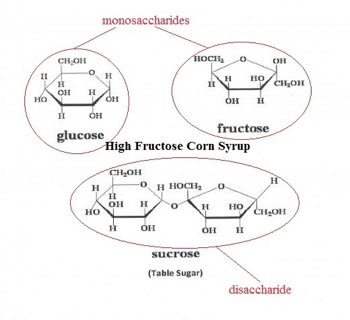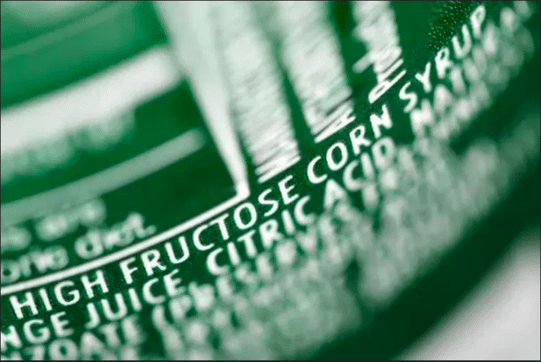In recent years high fructose corn syrup (HFCS) has evolved to become the pariah of the food industry, with bloggers and self-proclaimed food gurus touting its cause of everything from obesity, disease and body-wide inflammation to insulin intolerance, diabetes and death. But, just how true are these claims, and is there any evidence available to support them?
WHAT EXACTLY IS IT, AND WHY THE CONTROVERSY?
Before we start talking about HFCS, we should really talk about sugars. All sugars, of which ordinary table sugar is the most familiar, consist of various combinations of the basic building blocks: monosaccharides, or single sugars. A molecule of table sugar consists of one glucose, and one fructose, chemically bonded into what we call a disaccharide, or two sugars.
High fructose corn syrup consists of the same two monosaccharides; the only difference is that they're not bonded together. This one change makes it a liquid instead of a crystalline solid.

One thing to note about sugars which perhaps telegraphs the conclusion of this article — humans only absorb monosaccharides; no matter what form the sugar enters the digestive tract, it is only absorbed after it is broken down to its component monosaccharides. When you eat sugar, the very first thing your digestive system does is to break this bond. This starts happening the moment the sugar hits your saliva. This makes sugar and high fructose corn syrup, chemically, exactly the same.
SO WHY DO WE HAVE THIS LIQUID SUGAR?

HFCS give food manufacturers several important benefits. They’re easier to transport and handle in liquid form. They have certain advantages in baking, browning, and fermentability. They don't recrystallize after baking like sugar can, and they make foods moister. And perhaps most significantly, they allow the proportion of glucose and fructose to be adjusted. The fact is that not all sugars are equally sweet. If we assign sucrose (table sugar) a sweetness of 100%, glucose has a sweetness of 60 – 75% (on a gram-per-gram basis) and fructose has a sweetness of 140 – 170%.
Candy and soft drink manufacturers exploited the greater sweetness of fructose even before HFCS was available by using what is called ‘invert sugar’. Invert sugar is sucrose that has been treated with a weak acid solution and then recrystallized. This treatment causes a portion of the sucrose to break apart into fructose and glucose. Although the glucose part is less sweet than sucrose, the fructose is so much sweeter that the overall effect is to get more sweetness with less sugar. This allowed the manufacturers to use less sugar and thereby save money, even though invert sugar was more expensive than plain sucrose.
In 1957, a process was developed to convert some of the glucose in corn syrup to fructose, yielding a product that was 42% fructose and 58% glucose. This dramatically increased its sweetness, making a product that was a commercially viable competitor to sucrose as a sweetener. This was HFCS 42, which has a sweetness (gram-per-gram) slightly greater than sucrose (110%). The primary advantage of HFCS 42 to food manufacturers was its low cost — much lower than the cost of sucrose.
Later, HFCS manufacturers began distilling HFCS 42 through separation columns to produce syrup with 55% fructose, known as HFCS 55. With the introduction of HFCS 55, which is 25% sweeter than sucrose, food manufacturers found that the slightly increased price (which was still less than sucrose) was more than offset by the fact that they needed less of it to get the same level of sweetness.
That’s right, HFCS allowed food manufacturers to use less sugar (and thus fewer sugar calories) in their products without compromising sweetness. Using sucrose, cane or beet sugar, would require 20% more sugar (and 20% more sugar calories) than using HFCS 55.
Cost is such a huge factor. In the United States, we grow our corn; but we have to import our sugar. Countries all hit each other with import tariffs, so high fructose corn syrup is cheaper in North America, and sugar is cheaper in South America. That's the reason Coca-Cola is different north or south of the border.
HOW SAFE IS HFCS COMPARED TO OTHER SWEETENERS?
Let’s recap the facts:
- Fact 1: Humans only absorb monosaccharides; no matter what form the sugar enters the digestive tract, it is only absorbed after it is broken down to its component monosaccharides.
- Fact 2: All sugars are a combination of these monosaccharides
- HFCS 42 and HFCS 55 have essentially the same amount of fructose, as honey, sucrose (cane or beet sugar) or maple syrup/sugar (to be agonizingly precise, HFCS has slightly less, and HCFS 55 has slightly more).
- HFCS 42 and HFCS 55 have an equal or smaller amount of fructose, as a fraction of their total sugar, as many commonly consumed fruits.
- Agave syrup has higher fructose content than any type of HFCS except HFCS 90.
- Fact 3: Fructose is just a monosaccharide that is metabolized by the body. It is sweeter than other mono- and disaccharides, so less is needed, a lot less.
- Fact 4: HFCS is just a natural corn syrup with a higher fructose to glucose ratio to make it taste sweeter, so less is needed for the same sweetness.
The Internet is bursting at the seams with warnings that high fructose corn syrup is somehow poisonous or toxic or more harmful than regular sugar. The one place you won't find these warnings is in the scientific literature, where we consistently find there's no significant difference in their effect on the body, just as basic chemistry predicts.
In fact, high quality meta reviews of the research about the correlation between HFCS and T2DM and other metabolic conditions have consistently shown that the data does not show any causality between fructose and metabolic disease. I’ll list the research links below for those who haven’t had enough of the explanation so far.
SO, WHAT'S THE TAKEAWAY?
There is one warning about high fructose corn syrup that’s the same for the other sugars: You shouldn’t be eating any of them. And if you do, you should reduce your intake as much as possible – they’re ALL empty calories (and a lot of them at that), and will just make you fat. Any added sweetener exceeds the amount of sugars your body actually needs, which you already get from any normal diet.
So, if we’re looking for something responsible for our excess weight, HFCS isn’t at fault - but it sure is easy to blame instead of ourselves.
- InFact with Brian Dunning. https://infactvideo.com/episode/02/11/ Episode 11, Series 2 High Fructose Corn Syrup - They tell us High Fructose Corn Syrup has all kinds of health risks. Is there really any reason to avoid this common sugar substitute?
- Skeptical Raptor. https://www.skepticalraptor.com/skepticalraptorblog.php/high-fructose-corn-syrup-just-sugar/ 2017 - High fructose corn syrup – don’t be afraid, it’s just sugar
- Skeptical Raptor. https://www.skepticalraptor.com/skepticalraptorblog.php/high-fructose-corn-syrup-myth-science/ 2012 - High fructose corn syrup–myth versus science
- Science-Based Medicine. https://sciencebasedmedicine.org/high-fructose-corn-syrup/ Jim Laidler on August 23, 2010 - High Fructose Corn Syrup: Tasty Toxin or Slandered Sweetener?
- Dolan LC, Potter SM, Burdock GA. Evidence-based review on the effect of normal dietary consumption of fructose on development of hyperlipidemia and obesity in healthy, normal weight individuals. Crit Rev Food Sci Nutr. 2010 Jan;50(1):53-84. Review. PubMed PMID: 20047139.
- Elliott SS, Keim NL, Stern JS, Teff K, Havel PJ. Fructose, weight gain, and the insulin resistance syndrome. Am J Clin Nutr. 2002 Nov;76(5):911-22. Review. PubMed PMID: 12399260.
- Foster-Powell K, Holt SH, Brand-Miller JC. International table of glycemic index and glycemic load values: 2002. Am J Clin Nutr. 2002 Jul;76(1):5-56. PubMed PMID: 12081815.
- Goran MI, Ulijaszek SJ, Ventura EE. High fructose corn syrup and diabetes prevalence: a global perspective. Glob Public Health. 2013;8(1):55-64. doi: 10.1080/17441692.2012.736257. Epub 2012 Nov 27. PubMed PMID: 23181629. Impact factor=0.920.
- Heacock PM, Hertzler SR, Wolf BW. Fructose prefeeding reduces the glycemic response to a high-glycemic index, starchy food in humans. J Nutr. 2002 Sep;132(9):2601-4. PubMed PMID: 12221216.
- Rippe JM. The health implications of sucrose, high-fructose corn syrup, and fructose: what do we really know? J Diabetes Sci Technol. 2010 Jul 1;4(4):1008-11. PubMed PMID: 20663468; PubMed Central PMCID: PMC2909536.
- Rizkalla SW. Health implications of fructose consumption: A review of recent data. Nutr Metab (Lond). 2010 Nov 4;7:82. PubMed PMID: 21050460; PubMed Central PMCID: PMC2991323.
- Sievenpiper JL, de Souza RJ, Mirrahimi A, Yu ME, Carleton AJ, Beyene J, Chiavaroli L, Di Buono M, Jenkins AL, Leiter LA, Wolever TM, Kendall CW, Jenkins DJ. Effect of fructose on body weight in controlled feeding trials: a systematic review and meta-analysis. Ann Intern Med. 2012 Feb 21;156(4):291-304. doi: 10.7326/0003-4819-156-4-201202210-00007. Review. PubMed PMID: 22351714.
- Tappy L, Lê KA. Metabolic effects of fructose and the worldwide increase in obesity. Physiol Rev. 2010 Jan;90(1):23-46. Review. PubMed PMID: 20086073.

